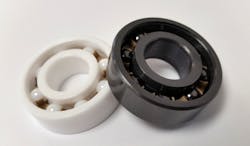"Space is a risky business,” once said Aaron Cohen, the Acting Deputy Administrator of NASA. “I always considered every launch a barely controlled explosion."
With several new space projects expected in the near future, these risks must be avoided at all costs. This puts a greater onus on engineers to create high-performing components that can withstand violent shuttle launches and inhospitable vacuums of space.
The United Nations (UN) has identified space-based services and technologies as being key to its 17 Sustainable Development Goals for 2030. Space technology, says its website, will be “key in understanding climate change and during the full disaster management cycle; only two examples among countless applications to which space can contribute to.”
Forbes magazine predicts several space technological developments over the coming years. They include green-oriented projects, like infra-red cameras on satellites to monitor thermal emissions produced by homes and businesses, and satellite imagery maps that will measure deforestation in relation to carbon usage.
Smaller payload trips to the Moon are also planned, adds Forbes, and the launch of more satellites. These projects will put more pressure on equipment manufacturers to source and use mission-critical machine components that can survive the vacuum of space. Vital components like sensors, solar cells, lenses, and semiconductors will be subjected to extreme temperature fluctuations due to the sun's unfiltered radiation, causing failures and millions of dollars worth of damage, in some cases.
These challenges also apply to bearings. A major problem is that ultraclean vacuum environments, especially those characterized by high or low temperatures or highly corrosive elements, can affect bearing life by an astonishing 90%. On the one hand, machine builders have been raising the performance requirements for bearings used in Earth-based applications like food processing and steel fabrication, specifically to enhance how they perform in highly corrosive environments and against exposure to moisture and chemicals.
But how can bearings withstand the vacuums of space, and increasing demand for their use in space applications?
Longer Life
The harsh conditions of space include demanding factors like an absolute vacuum, fluctuating temperatures, and the extreme and violent G-forces rocket components are subjected to during lift-off. To withstand these conditions, bearings should be space-approved—but what does this mean, exactly?
For a start, bearings for use in space should ideally meet the AS9102 Aerospace First Article Inspection standard that covers processes for manufacturing parts, from small electrical components to large structural assemblies, which are used in aviation, space, and defense. This is part of the AS9100 series of regulations, which is the ISO 9001 quality management system equivalent for aerospace. These standards put engineering demands on the bearing itself.
Take the ball cage, for instance—also called the retainer, which separates the bearing’s balls from the central rolling component. The cage can be made from AISI 304 austenitic stainless steel because of its excellent corrosion resistance and good performance at high temperatures. Coating stainless steel bearings in Polytetrafluoroethylene (PTFE), one of the world’s most versatile known plastic materials is also beneficial. PTFE is becoming more used outside spacecraft and has exhibited tensile, elongation, flex, and impact properties that are up to 10x better in vacuum environments than more commonly used fluorine-based plastics, like Tefzel (ETFE).
The bearings’ life should also be considered—especially if they are to be used in rolling elements aboard spacecraft that must remain operational away from Earth for years, decades or indefinitely. Lubrication is vital here, and low-outgassing and low-vapor pressure oils have been developed especially for space applications. Synthesized hydrocarbon or Perfluoropolyether (PFPE) liquid lubricants have been used in the aerospace industry for more than 30 years.
Aggressive Environments
Let’s look at other materials: ceramics, which are commonly used in thermal protection systems or heat shields in space.
Ceramics are shown to effectively withstand extreme temperature changes—such as when a spacecraft enters any type of atmosphere at high speeds, be it Earth or Mars. Ceramics have excellent low and high-temperature stability which means they can be used in deep space and cryogenics as well as furnace applications.
This brings us to ceramic bearings, which are often overshadowed by their steel-bearing counterparts due to their pros and cons.
First, the cons: the roundness of ceramic bear rings is not as good as those in high-precision steel bearings. Although ceramic bearings are harder than steel, the material is also more brittle. For this reason, full ceramic bearings are not used in very high-speed applications like machine tools or turbines. Super-precision hybrid bearings are preferred for these applications. Ceramic bearings are also more costly.
Nevertheless, ceramic bearings are used in aggressive environments where other materials are not suitable. They are most commonly used in applications where excellent corrosion resistance is required, along with exposure to extremely low or high temperatures. In other words, ceramic beings are ideal for use in space.
The most common materials used in SMB Bearings’ ceramic bearings are zirconia (ZrO2) and silicon nitride (Si3N4). Both have excellent corrosion resistance, These materials have a low friction coefficient, which brings us to a key advantage of full ceramic bearings: they can run constantly at speed without lubrication, which is why Si3N4 is often used in vacuum environments.
ZrO2 bearings can be used up to 752°F (400°C) and Si3N4 bearings up to 1,472°F (800°C). Also, for these temperatures, SMB Bearings recommends the bearings should be full-complement. This means the bearing doesn’t have a ball retainer and, instead, the free space allows additional balls to be fitted. This increase in ball complement allows for significant increases in radial bearing capacity although maximum speed is greatly reduced. Down to approximately -328°F (-200°C), ceramics also have excellent low-temperature performance provided a suitable cage is used.
With their lightweight and vacuum-compatible properties, silicon nitride bearings will be greatly relied upon in space-exploration applications. They will particularly benefit satellites and spacecraft, which need optimal weight capacities in order to perform enhanced flight dynamics and acceleration. These specialist bearings, along with their stainless steel counterparts, will be vital to ensuring that the next giant leap for mankind is a far-from-risky business.
For more information, download the Ceramic Bearings: Your Essential Guide to Ceramic Bearings white paper at SMB Bearings’ website, or email [email protected].
SMB Bearings originally specialized in miniature bearings, thin-section bearings, and stainless steel bearings. By natural progression, the company expanded the range to include other corrosion-resistant bearings such as plastic bearings, 316 stainless bearings, and ceramic bearings.
Remaining a specialist business, SMB Bearings provides a high level of product knowledge, providing bearing and lubrication solutions to existing or potential customers, whether individuals or large corporations. SMB Bearings does not just sell bearings but helps to solve your problems.
For further information please visit www.smbbearings.com.











